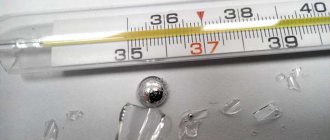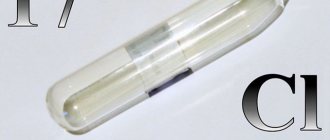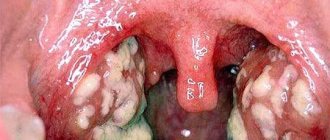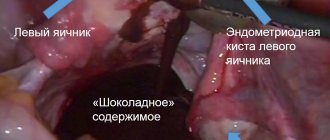Mercury is classified as a heavy metal, and is a rather dangerous substance that can cause serious poisoning in humans. What is its danger, and under what circumstances can mercury intoxication occur?
Today this metal is widely used both in chemical production and in everyday life. This is a strong toxic substance that can actively evaporate and form toxic fumes. Due to these properties, mercury cannot but pose a threat to human health, regardless of whether it is in any compounds or in its pure form.
How does mercury enter the body?
Mercury is a chemical element belonging to the zinc subgroup. The substance used in everyday life looks like a thick silvery liquid.
Mercury vapor is extremely poisonous and it is very difficult to remove it!!
. They enter the body by inhalation, through the gastrointestinal tract (swallowing) or through the skin.
Diagnostics
When making a diagnosis, the first step is to distinguish this disorder from other diseases of the gastrointestinal tract, kidneys and blood circulation disorders in the brain. In addition, diagnostic measures include:
- blood and urine tests to detect mercury particles in them. But it is worth remembering that within two weeks from the moment the metal first enters the body, these tests will have normal values. Therefore, if this is done before this time, there is a possibility of making an incorrect diagnosis;
- examination of the scalp - this method is carried out in chronic cases to determine the approximate time of mercury entering the body. The essence of such an examination is that in adults and children, hair grows by about one and a half centimeters every two months. With mercury poisoning, hair growth slows down;
- introduction into the body of a special solution that will show the presence of metal.
What to do if the thermometer breaks
A broken thermometer is a very common problem, especially in families with children. After flowing out, the mercury collects in small silvery balls. It is very important to collect them as quickly as possible, as the fumes are toxic to both people and animals.
Do you know what MRI is, is there any harm from it and how often can this study be performed?
Mercury collection activities
If a thermometer breaks in the house, follow this procedure:
- Take adults, children and pets out of the room and close the door.
- Open the windows in the room, but make sure there is no draft.
- Cover your face with a mask, damp cloth or gauze.
Spilled mercury is collected in several ways:
- medical syringe;
- rubber syringe (bulb);
- cotton pads;
- napkins made of bandage or gauze;
- a piece of paper;
- any tape or adhesive tape.
The collected mercury is placed in a glass jar, tightly closed with a lid and disposed of.
After collection, you need to carefully examine the surface; for this it is convenient to use a flashlight. Be sure to collect any remaining glass from the thermometer, as small pieces can stick into the skin. It is recommended to use rubber gloves when working.
REFERENCE! There are special services involved in cleaning premises from mercury. They measure the amount of vapor in the air, collect mercury globules and dispose of them.
What not to do
It is strictly forbidden to collect spilled mercury with a broom or broom. This will lead to the disintegration of the balls into fine dust, which is almost impossible to remove. You should also not use a vacuum cleaner, as the flow of hot air increases the evaporation of the metal.
A broken thermometer and a jar with collected balls are prohibited from being thrown into trash containers. Do not flush mercury down the toilet. The thermometer is placed in a jar where mercury balls were collected, and then it is handed over to special demercurization centers that dispose of toxic metal.
Danger of poisoning if mercury is not completely removed
Balls of mercury that are not completely removed continue to evaporate into the environment. They are especially dangerous for people suffering from chronic diseases. The first signs of illness begin only after a few weeks. Such symptoms include headaches, fatigue, weakness, irritability , etc.
Prevention measures
After cleaning the room and removing mercury balls, the following measures should be taken:
- If mercury gets on soft toys or other fleecy surfaces, it is recommended to burn or dispose of them. You can also put these things in the sun, and after a couple of months the mercury will completely evaporate.
- The contaminated surface is washed with a saturated solution of potassium permanganate. You can use bleach instead.
- After wet cleaning, the room is well ventilated for 2-4 hours, but there should be no draft.
REFERENCE! After finishing cleaning, you should take a shower and change clothes. The mouth can be thoroughly rinsed with a weak solution of manganese.
Is mercury from a thermometer dangerous?
Although today electric thermometers are replacing mercury thermometers, they still cannot fully compare with their ancestors. A mercury thermometer has a low error rate - up to 0.1 degrees. It is also worth highlighting its relatively low cost and great durability, which does not require either replacing batteries or recharging. This thermometer can be easily disinfected, but breaking it is also not difficult. Therefore, first of all, let’s find out what mercury from a thermometer is.
- As soon as the thermometer breaks, shards of glass and drops of mercury immediately appear. Let us recall that mercury belongs to the first class of dangerous and toxic substances , and is also number 80 in the periodic table.
- Mercury has several unique abilities - it is a single metal whose fluid state ranges from -19 to +357 °C. But do not forget that at a temperature of +18 °C mercury begins to evaporate!
- Consider also this feature: the higher the temperature and more sunlight, the faster evaporation occurs. If we take temperatures of 18-19°C and 24-25°C, then the rate of metal evaporation increases by 15-18 times. Now think about how many people have a room temperature that does not exceed 20°C. More often the minimum indicator reaches 22-23°C.
Important : The permissible levels of metal in a home per cubic meter should not exceed 0.0003 ml. The thermometer contains 2-5 g of the substance (by the way, 1-2 g of mercury is enough to poison 10 people). If metal evaporation occurs, then for an average room area of up to 20 m³, mercury vapor will be 300 thousand times more than the permissible limit!
- Mercury vapor is 80% not excreted from the body! Most of them enter through the lungs, but they can also poison the body through the skin or mucous membranes. The main “blow” falls on the kidneys and brain, but the surface of the respiratory tract can also be damaged. This is manifested by coughing up blood.
- Another interesting fact worth knowing is that mercury can evaporate equally in air and under water. Moreover, it quickly and firmly penetrates into any crevices, fabrics and other hard-to-reach places. It is extremely difficult to remove.
Mercury melts at a temperature of -39°C
Possibility of mercury poisoning due to a broken thermometer
With quick and thorough cleaning, the likelihood of poisoning from toxic fumes is extremely low. Daily ventilation of the room for 1-2 months will completely clear the air of remaining mercury vapor.
There is a danger of poisoning if small balls remain in the room. They can roll under the baseboard, get on soft toys, in a high-pile carpet, etc. The first signs of poisoning may appear only several months after the thermometer is broken, so it is important to properly clean the room.
Characteristics of mercury
Mercury is one of the heaviest and most dangerous metals. The substance is a silvery liquid, the vapors of which have a high degree of toxicity.
Metallic mercury, the kind found in a thermometer, is not as toxic as its liquid counterpart, but it is quite capable of causing poisoning and causing subsequent health problems.
Conventional thermometers contain about 2 grams of mercury; if it enters the human body in full, this dose is considered fatal. But here everything is individual; the occurrence of poisoning depends on:
- body weight;
- age;
- gender;
- room size;
- duration of contact with mercury.
Those most vulnerable to mercury exposure are children under 18 years of age, people over 65 years of age, and pregnant women. Mercury vapor has the most negative impact on them.
The risk of poisoning increases due to a broken thermometer in a small room. This also happens if the room is very hot or the heaters are on.
Mercury balls
If a thermometer was broken in a room and no measures were taken to eliminate mercury, then the possibility of poisoning is close to 100% due to its high concentration and toxicity.
Degrees of poisoning and their symptoms
Mercury vapor poisoning is divided into two types: chronic, called mercurialism, and acute. In the first case, toxic fumes affect the human body for several months and even years. In the second case, signs of poisoning are noticeable within a couple of hours.
The following symptoms are observed with mercurialism:
- drowsiness;
- dizziness;
- apathetic state;
- weakness;
- weakening of memory;
- “mercury tremor” (starts from the fingertips and gradually spreads to the whole body);
- decreased sense of smell;
- profuse sweating;
- enlargement of the thyroid gland;
- frequent urge to urinate;
- heart rhythm disturbance.
The acute form of poisoning can be recognized by the following symptoms:
- decreased appetite or lack thereof;
- severe pain in the head;
- suffocating cough;
- metallic taste in the mouth;
- swollen gums;
- vomit;
- sharp pain in the abdomen;
- diarrhea mixed with mucus or blood;
- fever;
- dyspnea.
In the acute form, a large amount of toxic metal is found in urine analysis.
In case of serious poisoning, death is possible, but a broken thermometer cannot lead to it.
Varieties
There are several forms in which mercury poisoning can occur:
- acute form - characterized by a sharp manifestation of signs of intoxication, including fever, severe headaches, frequent vomiting and diarrhea. Toxic shock can also develop, which, in turn, often causes a person’s death;
- chronic mercury poisoning - this type is characterized by a gradual increase in the intensity of symptoms. The violations to which this leads are expressed not only in external manifestations, but also in internal disorders.
How to provide first aid, antidote
At the first signs of mercury vapor poisoning, first aid must be provided:
- Remove the person from the room or area where the mercury was spilled.
- Give the victim 2-3 glasses of warm water to drink (you can use a weak manganese solution). After this, you need to induce vomiting by pressing on the root of the tongue with two fingers.
- Rinse your throat and mouth with manganese solution.
- Use the special antidote “Unitiol”. The drug is administered intramuscularly, the dosage is calculated according to the instructions (0.005 g of the drug is used per 1 kg of weight).
IMPORTANT! For mercury poisoning, do not use activated carbon, since it is not effective in this situation.
In case of serious poisoning, it is necessary to call an ambulance for hospitalization as soon as possible. In hospital settings, doctors use drugs that accelerate the removal of mercury from the body: Dimercaprol, Sodium Dithiolpropanesulfonate, D-Penicillamine.
How does x-ray affect the human body, radiation doses during various x-ray examinations. Is it possible to do x-rays for children, pregnant and lactating women?
It will also be useful to familiarize yourself with the most complete database of antidotes and medicines against all kinds of poisons.
Let's sum it up
Mercury is considered one of the dangerous poisons. And at the same time, it is a metal necessary in medicine. It is a component on which the operation of home thermometers and thermometers depends. Therefore, if used carefully, this metal does not pose a health hazard. But what if the thermometer is broken?
To avoid the consequences of mercury poisoning, you need to take several basic actions: remove people from the room, close the door and open the window. Metal balls should be collected using all available safety precautions. Avoid common mistakes when doing this. At the same time, you should pay attention to the health status of those exposed to mercury. If your health worsens, you need to take measures to reduce the harmful effects of the poison on the body.
If there are symptoms of poisoning in children, elderly or pregnant women, you should call an ambulance and provide the necessary first aid. If you work in an enterprise that uses heavy metals and toxic substances such as mercury, you should carefully monitor your condition. If signs of chronic poisoning appear, you should consult a doctor. And if the prescribed treatment does not help improve the situation, you may have to think about changing your workplace.
How can you detect mercury vapor indoors?
To determine the amount of mercury vapor in a room, special analyzers are used (RA-915+, Mercury, etc.). Indicators are also used. To make them, filter paper is used, which is impregnated with selenium sulfide or copper monodide.
Such indicators, cut into strips of 1*6 cm, are suspended at a level of 1-1.5 meters for 8-10 hours. After this time, the color of the paper strip is assessed. If it turns pink, it means there is an increased concentration of mercury vapor in the air.
Gas analyzers are also used to determine the concentration of toxic vapors. These devices measure the level of mercury vapor with high accuracy in a few seconds. In order to measure the concentration of mercury in this way, it is necessary to call demercurization specialists.
Treatment
In case of poisoning with a large amount of mercury, it is necessary to call an ambulance, and before the doctors arrive, provide first aid for mercury poisoning. To do this you need to do the following:
- remove or remove the victim to fresh air;
- try to flush your stomach. If this cannot be done, it is necessary to give the victim activated carbon, in the ratio of one tablet per ten kilograms of body weight, or water with the addition of egg whites;
- let you drink as much ordinary purified water as possible, not strong tea or milk;
- it is necessary to lay the victim down and turn his head to the side so that the person does not choke on vomit;
- if poisoning occurs at home, it is necessary to give medications containing calcium or glucose. In addition, you need to collect small balls of mercury as quickly as possible;
- if possible, take a contrast shower and change clothes.
Upon arrival of doctors, the patient is taken to a medical facility, where he is prescribed injections of a dimercapto compound and treated for concomitant pathologies of internal organs.
In most cases, the prognosis for poisoning is favorable - the mortality rate is extremely low.
Where else is mercury found?
In addition to thermometers, there are other sources of this toxic metal. It is used for the production of mercury and fluorescent lamps. The level of metal in them varies from 1 to 70 mg.
Medical sources include some drugs for the production of which they use preservatives based on the mercury-containing compound Thiomersal (antidotes, some vaccines, etc.). Also, a toxic compound is present in very small quantities in dental fillings containing the substance amalgam.
Mercury is found in seafood: fish and some shellfish. Increased consumption of these products during pregnancy can lead to exposure of the fetus to a toxic substance. This is especially true among populations whose diet consists largely of fish containing mercury.
Man-made sources of toxic metal include mercury-zinc batteries, as well as pressure gauges, switches, thermometers, pumps and other devices containing mercury. However, nowadays most equipment is being replaced with devices that do not contain this toxic substance.
Mercury poisoning can be dangerous, but a broken thermometer rarely causes serious health problems. It is very important to properly collect spilled metal in a short time and dispose of it correctly, otherwise chronic poisoning may develop.
What not to do
If you see one of your relatives’ thermometer broken, you should understand that certain actions can only worsen the situation:
- Do not remove mercury beads with a vacuum cleaner. Metal particles tend to stick to this unit. Therefore, you will not only not eliminate the cause of the infection, but will also contribute to its spread further;
- sweeping with a broom is also not recommended, since this tool not only does not penetrate into hard-to-reach places, such as under a bed, chair or sofa, but is also capable of driving mercury particles there;
- Do not dispose of mercury in a garbage disposal or sewer. Don't put your neighbors' health at risk;
- If poison gets on clothing, it is better to throw it away. Don't try to wash it in the machine. This way you risk leaving traces of this dangerous metal all over your wardrobe. If this item is too expensive, it is better to air it in the sun for as long as possible.
By remembering simple precautions, you can protect your health and life.
Causes of mercury poisoning
Sources of mercury poisoning are:
- mercury lamps;
- mercury thermometers;
- fluorescent gas-discharge energy-saving lamps;
- mercury-zinc batteries;
- dental fillings with amalgam;
- medications: mercuzal, calomel, sublimate;
- industrial combustion of gas or coal in large quantities;
- fish or shellfish living in environmentally polluted waters;
- places of natural origin of mercury.











